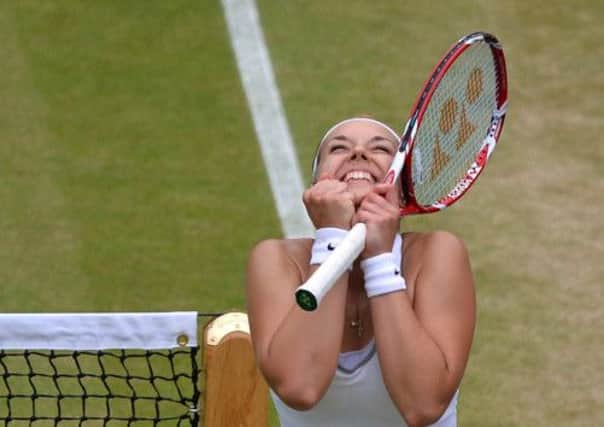Wimbledon: Lisicki stays on track with Kanepi win


It seems the emotional high of causing an upset is followed by a low. The nervous excitement ebbs, and it is tough to get anywhere close to the same level.
If anyone looked set to be the next victim of that syndrome, it was Sabine Lisicki. The German was moved to tears by her victory over Serena Williams on Monday, and had less than 24 hours to recover before she was back on court for her quarter-final against Kaia Kanepi.
Advertisement
Hide AdAdvertisement
Hide AdBut recover she did, comprehensively. Far from appearing drained by her win over the No 1 seed and overwhelming favourite, Lisicki looked inspired by it.
The unseeded Estonian at least matched her for raw power, and if it had come down to a slugfest, Lisicki could have been worn down. But the No 23 seed has a lot more to her game than that, and her range of shots ensured her of a reasonably comfortable 6-3, 6-3 victory that takes her through to a semi-final against Agnieszka Radwanska.
The first set was essentially decided in the opening game: Kanepi lost her serve, and Lisicki had little trouble in staying ahead after that. The second set was a little more complex, with Lisicki being broken in the third game to go 2-1 down.
But from there she rattled off four games on the trot, exposing Kanepi’s relative immobility with some delightful drop shots and lobs. After that, Lisicki displayed a touch of nerves when serving for the match, but she had the presence of mind to compose herself and clinch her place in the last four with her third match point.
“Especially after yesterday’s win, I was ready today,” Lisicki said. “I knew from the past out of experience that I needed to make the switch quickly to be ready, and that’s what I did.
“I think you saw that even in the press conference yesterday that I was already back to the business that I had to play out there again today.
“That’s at least what I was thinking about. I think I did a good job with that.
“I was just as focused as yesterday, because I knew I had to be even more because I knew it’s going to be tough after yesterday’s match to just keep the level up. But, you know, I think I did a very good job to go for my shots and play smart. It had to be a different game today.”
Advertisement
Hide AdAdvertisement
Hide AdEven discounting the Williams match, Lisicki has had a tough path to the last four. She got the better of former French Open champion Francesca Schiavone in the first round, world No 22 Elena Vesnina in the second, and No 14 seed Sam Stosur in the third.
Speaking of the French Open, the 23-year-old has got the better of the reigning champion from Roland Garros at each of her last four Wimbledons. You need to be good on grass to achieve that sort of consistency, and if the seeding here was a real assessment of form on the surface Lisicki would surely have been placed a lot higher this year.
By making it to the last four she has equalled her best achievement of two years ago, when she lost to Maria Sharapova. If she plays as well tomorrow as she has done in her last two rounds, she has a good chance of going one better.
“Agnieszka plays a very smart game,” she said of her next opponent, the No 4 seed. “She moves well around the court. She was in the final last year, so she has a lot of confidence with that.”
Lisicki has a lot of confidence too, born of a belief that she has nothing to lose. She has always appeared to enjoy her tennis, and an ankle injury a couple of years back only strengthened her enthusiasm for the sport. “Three years ago when I couldn’t walk, I had to learn how to walk again, and that made me appreciate every single moment out there a lot more,” she said. “That’s why I don’t let anybody take that away from me.
“Once you have to learn how to walk again, it just shows you how we actually have to appreciate to have two healthy legs and be able to walk. Being on crutches, you can’t carry anything. You need the help of somebody else. So just being able to walk again and carry my own stuff was great.
“And then, you know, to come back on the court to compete and then to go even further than I did before the injury gives you a lot of strength. It’s a different feeling when you’re out there now.”